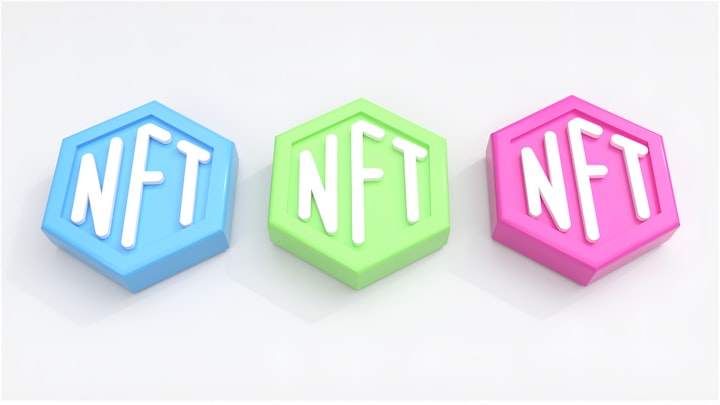The Rise of NFTs: How Digital Artists Are Revolutionizing the Art World
To work online click on link below

The world of art has always been closely tied to physical objects. Paintings, sculptures, and other works of art have traditionally been bought and sold as physical items.
However, in recent years, a new type of digital asset has emerged that is changing the way we think about art ownership and value.
These assets are called non-fungible tokens, or NFTs for short.
NFTs are digital assets that are stored on a blockchain, which makes them unique and unalterable. They can take many forms, such as art, music, videos, and even tweets.
Each NFT is essentially a digital certificate of ownership that proves you own a specific piece of content.
The ownership of an NFT is verified by the blockchain, which ensures that the owner is the only person who can claim ownership.
NFTs have become particularly popular in the art world, where they're being used to sell digital art for millions of dollars.
In March 2021, a digital artwork by Beeple sold for $69 million at a Christie's auction, making it the most expensive NFT ever sold.
The rise of NFTs has also given rise to a new generation of digital artists.
These artists are using NFTs to monetize their digital content in a way that was previously impossible. By turning their digital creations into NFTs, they can sell them as unique assets that hold value.
The Benefits and Challenges of Selling Digital Art as NFTs:
The world of digital art has been around for decades, but it's only recently that it's started to gain recognition as a legitimate art form.
With the rise of non-fungible tokens (NFTs), digital art is now being sold for significant amounts of money, and artists are finally able to monetize their work in a way that was previously impossible.
NFTs are digital assets that are stored on a blockchain, which makes them unique and unalterable. Each NFT is essentially a digital certificate of ownership that proves you own a specific piece of content.
The ownership of an NFT is verified by the blockchain, which ensures that the owner is the only person who can claim ownership.
One of the most significant benefits of selling digital art as NFTs is that it allows artists to monetize their work in a way that was previously impossible.
Digital art has always been difficult to sell because it's easy to copy and reproduce. By turning their digital creations into NFTs, artists can sell them as unique assets that hold value.
Another benefit is that NFTs provide proof of ownership and authenticity, which is important in a world where digital content can be easily copied and shared.
The blockchain ensures that the owner of an NFT is the only person who has the right to claim ownership.
However, selling digital art as NFTs also comes with its challenges. One challenge is that the market for NFTs is still relatively new and somewhat unpredictable. It's difficult to know how much an NFT will sell for, and there's always the risk that it won't sell at all.
The Role of Social Media in the Popularity of NFT Art: How One Tweet Can Sell millions and the Benefits and Challenges of Selling Digital Art as NFTs:
The world of digital art has been around for decades, but it's only recently that it's started to gain recognition as a legitimate art form.
With the rise of non-fungible tokens (NFTs), digital art is now being sold for significant amounts of money, and artists are finally able to monetize their work in a way that was previously impossible.
NFTs are digital assets that are stored on a blockchain, which makes them unique and unalterable. Each NFT is essentially a digital certificate of ownership that proves you own a specific piece of content.
The ownership of an NFT is verified by the blockchain, which ensures that the owner is the only person who can claim ownership.
One of the most significant benefits of selling digital art as NFTs is that it allows artists to monetize their work in a way that was previously impossible.
Digital art has always been difficult to sell because it's easy to copy and reproduce. By turning their digital creations into NFTs, artists can sell them as unique assets that hold value.
Another benefit is that NFTs provide proof of ownership and authenticity, which is important in a world where digital content can be easily copied and shared.
The blockchain ensures that the owner of an NFT is the only person who has the right to claim ownership.
However, selling digital art as NFTs also comes with its challenges. One challenge is that the market for NFTs is still relatively new and somewhat unpredictable. It's difficult to know how much an NFT will sell for, and there's always the risk that it won't sell at all.
The Role of Social Media in the Popularity of NFT Art: How One Tweet Can or Millions:
In the digital age, social media has become an indispensable part of our lives, transforming the way we communicate, share information, and even how we experience art.
In recent years, a groundbreaking phenomenon has taken the art world by storm - Non-Fungible Tokens (NFTs).
These unique digital assets, built on blockchain technology, have revolutionized the art market and opened up new possibilities for artists and collectors alike.
But what exactly is the role of social media in the skyrocketing popularity of NFT art? How can a single tweet turn into a multimillion-dollar sale?
Social media platforms have played a significant role in the rapid dissemination and adoption of NFT art.
Artists, both established and emerging, have leveraged the power of platforms like Twitter, Instagram, and TikTok to promote and sell their digital creations.
Social media allows artists to directly connect with their audience, bypassing traditional gatekeepers like galleries and auction houses.
It provides a democratized space where artists can build their brand, gain exposure, and attract potential buyers from across the globe.
NFT Art and the Future of Museums: Virtual Galleries and the Democratization of Art:
NFTs, unique digital assets built on blockchain technology, have not only disrupted the traditional art market but also opened up a world of possibilities for museums and art institutions.
In this digital era, virtual galleries are emerging as a powerful tool, democratizing access to art and transforming the way we engage with cultural institutions.
NFTs have propelled art into the digital realm, allowing artists to tokenize their work, establish verifiable ownership, and enable transparent transactions on the blockchain.
From digital art and collectibles to virtual reality experiences and even music, NFTs have unleashed a wave of creativity and redefined what can be considered valuable and collectible.
These digital assets have gained immense popularity, fetching millions of dollars in auctions and capturing the attention of collectors worldwide.
With the rise of NFT art, virtual galleries have emerged as a dynamic and immersive way to experience and showcase artwork.
These digital spaces transcend physical limitations, offering a global audience the opportunity to explore exhibitions, interact with artworks, and engage with fellow art enthusiasts, regardless of their geographical location.
Virtual galleries provide a unique platform for artists to showcase their NFT art, breaking free from the constraints of physical galleries and reaching a wider audience.
Museums, too, are beginning to embrace the concept of virtual galleries, pushing the boundaries of how art can be curated and exhibited.
In conclusion:
The rise of non-fungible tokens (NFTs) has brought about significant changes to the art world. NFTs have allowed digital artists to monetize their work in a way that was previously impossible and has also provided proof of ownership and authenticity for buyers.
However, selling digital art as NFTs also comes with its challenges, such as the unpredictability of the NFT market and the time-consuming process of creating an NFT.
Social media has played a vital role in the popularity of NFT art. It has allowed artists to share their work with a vast audience, creating excitement and hype around digital art.
However, social media has also raised concerns about the environmental impact of blockchain technology and the potential for market manipulation.
The future of museums is also being impacted by NFT art. The potential for virtual galleries to democratize access to art is exciting, particularly for those who don't have the means to visit
physical museums or purchase expensive artwork. However, museums face challenges in acquiring and displaying NFT art, particularly as the technology continues to evolve.
Overall, NFT art is an exciting new frontier in the world of art. The benefits and challenges of selling digital art as NFTs, the role of social media in the popularity of NFT art,
and the future of museums in a world where digital art is becoming more valuable are all important topics to explore as we continue to navigate this rapidly-evolving landscape.
If you are interested in working online: Click Here





Comments
There are no comments for this story
Be the first to respond and start the conversation.